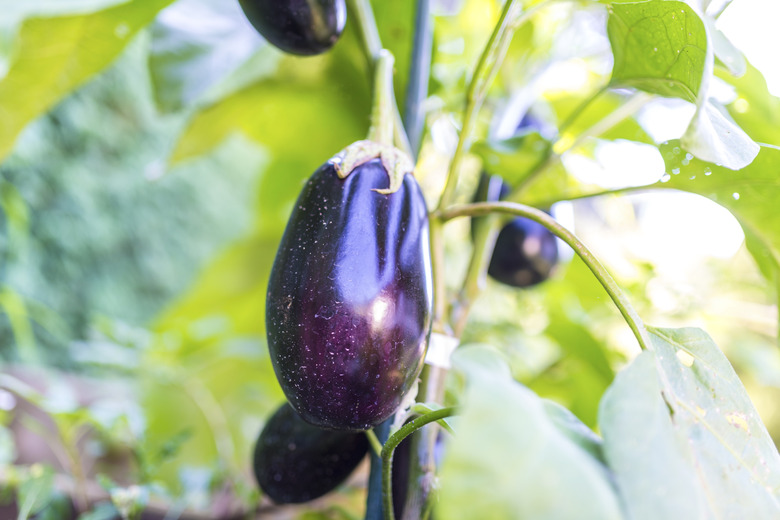Plants Containing Nicotine
Nicotine is the addictive chemical in tobacco products. Tobacco plants contain high levels of nicotine, but other members of the family of nightshade plants (Solanaceae), which includes tomatoes and eggplants, also produce low levels of nicotine. Nicotine production is not confined to nightshade plants, however, and examples of non-nightshade nicotine-containing plants include cauliflower and papaya plants. The measured amounts of nicotine vary with the growth stage of the plant, the plant part that is used for extraction and the method of extraction. One of the reasons that plants may produce nicotine is as a defense mechanism against predators.
Nicotine Content of Tobacco Plants
Nicotine Content of Tobacco Plants
Tobacco plants belong to the genus Nicotiana and encompass a large number of annual, biennial and perennial species. The commercial tobacco plant (Nicotiana tabacum) grows best in United States Department of Agriculture plant hardiness zones 8 through 11.
The tobacco plant synthesizes nicotine in its roots and then stores it in its leaves. Nicotine constitutes 0.3% to 0.5% of the tobacco plant's dry weight. Tobacco plants belong to the nightshade family of plants, and all tobacco species, including the ornamental ones, contain some nicotine.
Nicotine in Vegetable and Fruit Plants
Nicotine in Vegetable and Fruit Plants
Vegetable plants that belong to the nightshade family contain low amounts of nicotine. These plants include potatoes (Solanum tuberosum), tomatoes (Lycopersicon esculentum) and eggplant (Solanum melongena).
Eggplant contains one of the highest concentrations of nicotine: 100 nanograms, or 0.1 micrograms, of nicotine per gram of eggplant. Most of the nicotine in potatoes is concentrated in the flesh and not the potato skin. Green tomatoes contain about ten times more nicotine than ripe tomatoes.
Celery (Apium graveolens) and cauliflower (Brassica oleracea) are vegetables outside the nightshade family that also contain low amounts of nicotine. The papaya plant (Carica papaya), another non-nightshade plant, contains nicotine in its plant parts but not its fruits.
Nicotine in Herbs and Weeds
Nicotine in Herbs and Weeds
Deadly nightshade (Atropa belladonna), a perennial weed growing in United States Department of Agriculture zones 5 through 9, contains nicotine – but its toxic effects are mostly due to its other plant alkaloids, such as atropine. Other weeds, such as milkweed (Asclepias syriaca) and jimsonweed (Datura stramonium) also contain low amounts of nicotine. Milkweed contains nicotine only in its sprout seedling, while nicotine is present in all parts of jimsonweed.
Field horsetail (Equisetum arvense) is an herb that contains the alkaloids nicotine and palustrine. Although field horsetail contains a relatively high amount of nicotine, the amount is dwarfed by the nicotine content of the tobacco plant. Field horsetail contains 0.4 parts per million, while tobacco leaves contain 20,000 to 40,000 parts per million of nicotine.
Nature's Use of Nicotine
Nature's Use of Nicotine
Plants primarily use nicotine to ward off predators. In studies at the Max Planck Institute in Germany, published in PLOS Biology in 2004, when coyote tobacco (Nicotiana attenuata) plants were engineered to lack nicotine, the plants were more readily devoured by insects than tobacco plants that contained nicotine. Early insecticides often used nicotine as one of their constituents.
Interestingly, some creatures that munch on nicotine-containing plants also use nicotine to repel their own predators. Hornworms that feed on nicotine-free plants are more likely to be eaten by wolf spiders than hornworms that feed on nicotine-containing tobacco plants, according to a study published in the Proceedings of the National Academy of Sciences. Hornworms on a nicotine plant diet will exhale nicotine from their midgut, repelling the wolf spiders.
Also, humans who eat food containing nicotine may benefit from some protection from Parkinson's disease, notes Medical News Today. Preliminary research shows that dietary nicotine may lower the risk of developing Parkinson's, but more research is needed to conclude that nicotine is clinically effective in slowing this disease.
Cite This Article
MLA
Blue, Marie-Luise. "Plants Containing Nicotine" sciencing.com, https://www.sciencing.com/plants-containing-nicotine-12400023/. 30 September 2021.
APA
Blue, Marie-Luise. (2021, September 30). Plants Containing Nicotine. sciencing.com. Retrieved from https://www.sciencing.com/plants-containing-nicotine-12400023/
Chicago
Blue, Marie-Luise. Plants Containing Nicotine last modified March 24, 2022. https://www.sciencing.com/plants-containing-nicotine-12400023/
